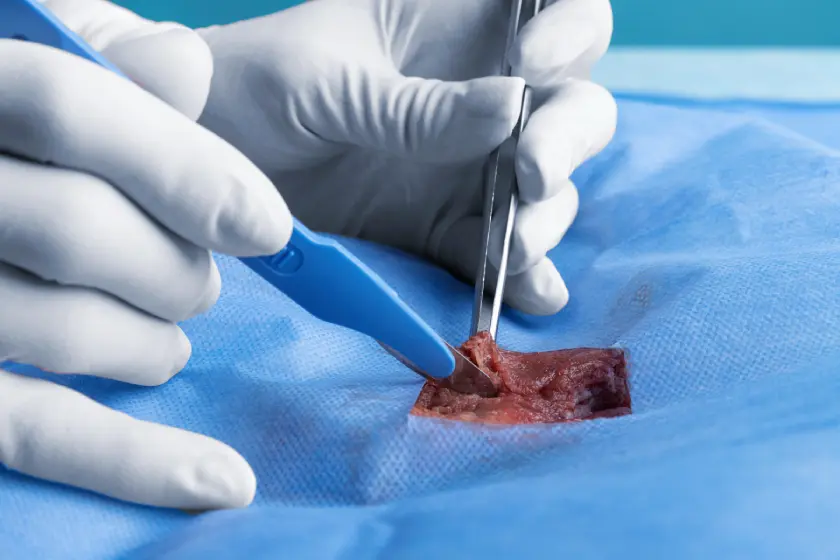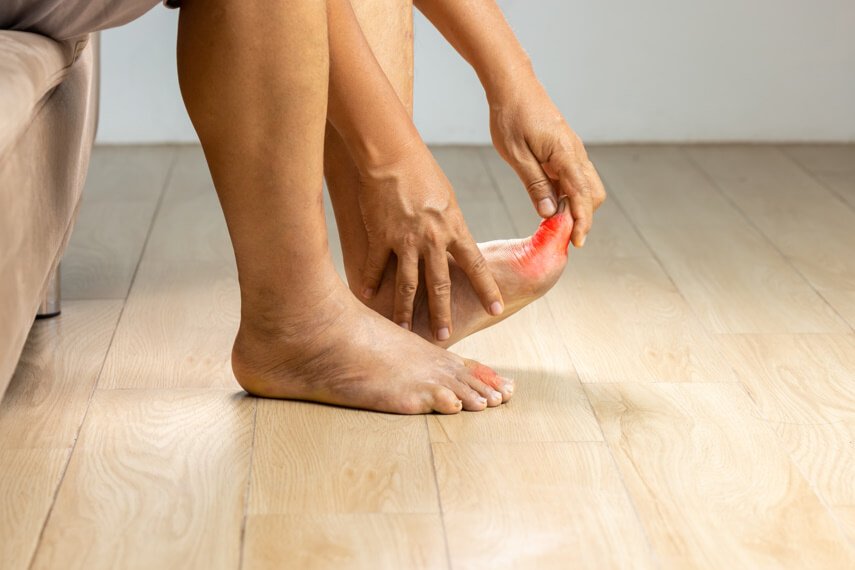Free Flap Surgery for Lower Limb Diabetic Wound Reconstruction
The Challenge of Diabetic Foot Wounds
Foot ulcers are among the most severe complications of diabetes, often leading to prolonged suffering and potential amputation. These wounds often resist healing due to poor circulation, neuropathy, and impaired immune response, leading to prolonged suffering and a high risk of amputation.
Traditional diabetic wound treatment methods like dressings, offloading, and debridement, sometimes fail to heal extensive wounds exposing bone or tendon. In such cases, free flap surgery offers hope, enabling wound closure and limb salvage where other treatments cannot.
What Is Free Flap Surgery?
Free flap surgery is an advanced reconstructive surgical technique crucial for managing complex wounds, especially in diabetic foot surgery. In this procedure, a section of tissue, such as skin, fat, muscle, or bone, is completely detached from its original location along with its artery and vein. This tissue, known as a free flap, is then transferred to the wound site to provide robust coverage and promote healing.
Using precise microsurgical methods, the surgeon connects the flap’s blood vessels to recipient vessels at the wound site to restore blood flow, ensuring the tissue remains viable. This free flap procedure is essential in diabetic wound treatment where ulcers expose bones, tendons, or joints, or when infections have led to extensive tissue loss. By bringing in healthy, vascularised tissue, free flap surgery not only closes the wound but also controls infection, accelerates healing, and prevents major amputations in patients with foot ulcers and diabetes.
When is a Free Flap Procedure Recommended?
A free flap procedure is recommended in severe cases where diabetic wound treatment with standard therapies like dressings, offloading, and skin grafting has failed to achieve healing. Patients with foot ulcers and diabetes often develop deep wounds exposing tendons, bones, or joints, making simple closure techniques ineffective. In such situations, free flap surgery provides healthy, well-vascularised tissue that promotes rapid healing and covers exposed structures effectively.
Additionally, if there is large tissue loss due to infection or surgical debridement, especially in diabetic foot infections requiring extensive removal of dead tissue, the free flap procedure becomes crucial to fill these defects and restore function. Limb salvage is always prioritised over amputation in diabetic foot surgery because losing a limb drastically affects mobility, independence, and quality of life. Therefore, when other diabetic wound treatment options fail, free flap surgery offers the best chance to save the limb and improve long-term outcomes.
A free flap procedure is considered when:
- Diabetic wound treatment with conventional therapy fails.
- The wound has exposed tendons, bones, or joints.
- Large tissue loss due to infection or surgical debridement exists.
- Limb salvage is preferred over amputation.
Benefits of Free Flap in Diabetic Foot Surgery
Enhanced Healing
The free flap procedure brings healthy, well-vascularised tissue to the wound area, promoting rapid healing where skin grafts or local flaps may fail.
Infection Control
By filling dead spaces with vascularised tissue, free flap surgery helps fight infection - a crucial factor in diabetic wound treatment.
Prevention of Amputation
This technique plays a vital role in diabetic foot surgery, helping avoid below-knee or above-knee amputations, which significantly impact mobility and quality of life.
Functional Restoration
Muscle flaps can restore contour and protect underlying structures, enabling patients to regain foot function and weight-bearing capacity.
How the Free Flap Procedure Works
Step 1: Preoperative Assessment
- Evaluate the patient’s health, glucose control, and vascular status.
- Imaging (CT angiography or Doppler) assesses recipient vessels.
- Infection control with antibiotics and wound debridement.
Step 2: Flap Harvesting
Tissue is harvested from a donor site (e.g. thigh, back) with its artery and vein intact.
Step 3: Transfer and Insetting
The flap is shaped to cover the wound and placed precisely for optimal contour and function.
Step 4: Microsurgical Anastomosis
Using a microscope, surgeons connect the flap’s blood vessels to those at the wound site to ensure continuous blood flow - the defining step of a free flap procedure.
Step 5: Closure
Both donor and recipient sites are closed, and the flap is carefully monitored.
Recovery and Post-Operative Care
Post-surgery care is crucial for successful diabetic wound treatment:
- Flap Monitoring: Checking for colour changes, temperature, or swelling indicating vascular issues.
- Glucose Control: Strict diabetes management to enhance healing.
- Pressure Offloading: Prevents pressure-induced flap damage.
- Physiotherapy: Gradual rehabilitation to restore mobility and strength.
Most patients begin gentle movement within days, with full recovery taking several weeks to months, depending on wound severity and overall health.
Risks and Considerations
While free flap surgery has high success rates, certain risks exist:
- Flap Failure: Due to thrombosis or poor vascular connection. Early detection can save the flap.
- Donor Site Morbidity: Scarring, weakness, or aesthetic concerns depending on the harvest area.
- Infection: Despite sterile techniques, infection risk persists, especially in diabetics with poor immune function.
- Medical Complications: Cardiac or renal issues may affect surgical eligibility.
However, with skilled microsurgeons and multidisciplinary diabetic wound care, these risks can be minimised, offering excellent outcomes.
When to See a Diabetic Wound Specialist
If you have foot ulcers and diabetes with:
- Wounds not healing despite weeks of care.
- Exposed bone, tendon, or joint.
- Recurrent infections or deep abscesses.
- Advice for possible amputation.
Consulting a diabetic wound treatment and reconstructive surgery specialist can open options for limb salvage using free flap surgery.
Conclusion
Free flap surgery is a transformative procedure in diabetic foot surgery, especially for complex wounds unresponsive to conservative treatments. By bringing in healthy, vascularised tissue, the free flap procedure accelerates healing, restores function, and prevents limb loss in patients with severe foot ulcers and diabetes.
If you or a loved one is struggling with non-healing diabetic wounds, speak to a reconstructive microsurgeon to explore the benefits of free flap surgery. Early intervention can save limbs - and lives.
FAQs
What is the role of a free flap surgery in treating diabetic foot wounds?
A free flap surgery plays a critical role in advanced diabetic wound treatment, especially when standard therapies like dressings and debridement fail. It involves transferring healthy, vascularised tissue to cover complex wounds, often caused by foot ulcers and diabetes, helping prevent infections and avoid amputations.
When is a free flap procedure recommended for diabetic foot patients?
A free flap procedure is recommended when diabetic wound treatment through conventional means does not result in healing. It is especially useful in diabetic foot surgery where the wound exposes bone, tendon, or joint, or when there is significant tissue loss due to infection or surgical removal.
How does free flap surgery differ from skin grafting in diabetic wound treatment?
While skin grafts cover surface wounds, free flap surgery provides deeper, more robust coverage using muscle, skin, or fat with its own blood supply. In severe diabetic foot surgery cases, where tissue is lost or infection is widespread, the free flap procedure ensures faster healing and functional restoration that skin grafts cannot achieve.
Can free flap surgery help prevent amputations in cases of foot ulcers and diabetes?
Yes, free flap surgery is often a limb-saving technique in patients suffering from severe foot ulcers and diabetes. By introducing healthy, well-vascularised tissue, it accelerates healing and significantly reduces the risk of major amputation in chronic diabetic wounds treatment.
Is free flap surgery safe for patients with diabetic foot wounds?
When performed by skilled microsurgeons and combined with proper glucose control, a free flap procedure is a safe and effective option for complex diabetic wound treatment. Though it carries some risks, it greatly improves outcomes in patients with non-healing foot ulcers and diabetes.



.jpg)

